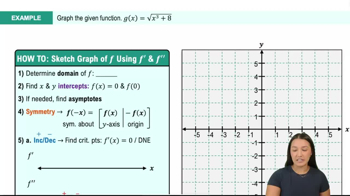Table of contents
- 0. Functions7h 52m
- Introduction to Functions16m
- Piecewise Functions10m
- Properties of Functions9m
- Common Functions1h 8m
- Transformations5m
- Combining Functions27m
- Exponent rules32m
- Exponential Functions28m
- Logarithmic Functions24m
- Properties of Logarithms34m
- Exponential & Logarithmic Equations35m
- Introduction to Trigonometric Functions38m
- Graphs of Trigonometric Functions44m
- Trigonometric Identities47m
- Inverse Trigonometric Functions48m
- 1. Limits and Continuity2h 2m
- 2. Intro to Derivatives1h 33m
- 3. Techniques of Differentiation3h 18m
- 4. Applications of Derivatives2h 38m
- 5. Graphical Applications of Derivatives6h 2m
- 6. Derivatives of Inverse, Exponential, & Logarithmic Functions2h 37m
- 7. Antiderivatives & Indefinite Integrals1h 26m
- 8. Definite Integrals4h 44m
- 9. Graphical Applications of Integrals2h 27m
- 10. Physics Applications of Integrals 2h 22m
5. Graphical Applications of Derivatives
Curve Sketching
Problem 33
Textbook Question
Graphing functions Use the guidelines of this section to make a complete graph of f.
f(x) = (x2 + 12)/(2x + 1)
 Verified step by step guidance
Verified step by step guidance1
Identify the domain of the function f(x) = (x^2 + 12)/(2x + 1). The denominator cannot be zero, so set 2x + 1 ≠ 0 and solve for x to find the domain.
Find the x-intercepts by setting the numerator equal to zero: x^2 + 12 = 0. Solve for x to determine if there are any real x-intercepts.
Determine the y-intercept by evaluating f(0). Substitute x = 0 into the function and simplify to find the y-intercept.
Identify any vertical asymptotes by setting the denominator equal to zero: 2x + 1 = 0. Solve for x to find the vertical asymptote.
Analyze the end behavior of the function by finding the horizontal asymptote. Compare the degrees of the numerator and denominator. Since the degree of the numerator is greater than the degree of the denominator, perform polynomial long division to find the slant asymptote.
 Verified video answer for a similar problem:
Verified video answer for a similar problem:This video solution was recommended by our tutors as helpful for the problem above
Video duration:
14mPlay a video:
Was this helpful?
Key Concepts
Here are the essential concepts you must grasp in order to answer the question correctly.
Function Analysis
Function analysis involves examining the properties of a function, such as its domain, range, intercepts, and asymptotes. For the given function f(x) = (x² + 12)/(2x + 1), understanding these properties is crucial for graphing. This includes identifying where the function is defined and any points where it may not exist, such as vertical asymptotes.
Recommended video:

Derivatives Applied To Velocity
Limits and Asymptotes
Limits help determine the behavior of a function as it approaches certain points, particularly at infinity or points of discontinuity. For rational functions like f(x), vertical asymptotes occur where the denominator equals zero, while horizontal asymptotes indicate the function's behavior as x approaches infinity. Analyzing these limits is essential for sketching the graph accurately.
Recommended video:

Cases Where Limits Do Not Exist
Critical Points and Derivatives
Critical points are values of x where the derivative of a function is zero or undefined, indicating potential local maxima, minima, or points of inflection. To find these points for f(x), one must compute the derivative and solve for x. Understanding the behavior of the function at these points is vital for creating a complete and accurate graph.
Recommended video:

Critical Points

 11:41m
11:41mWatch next
Master Summary of Curve Sketching with a bite sized video explanation from Callie
Start learning




